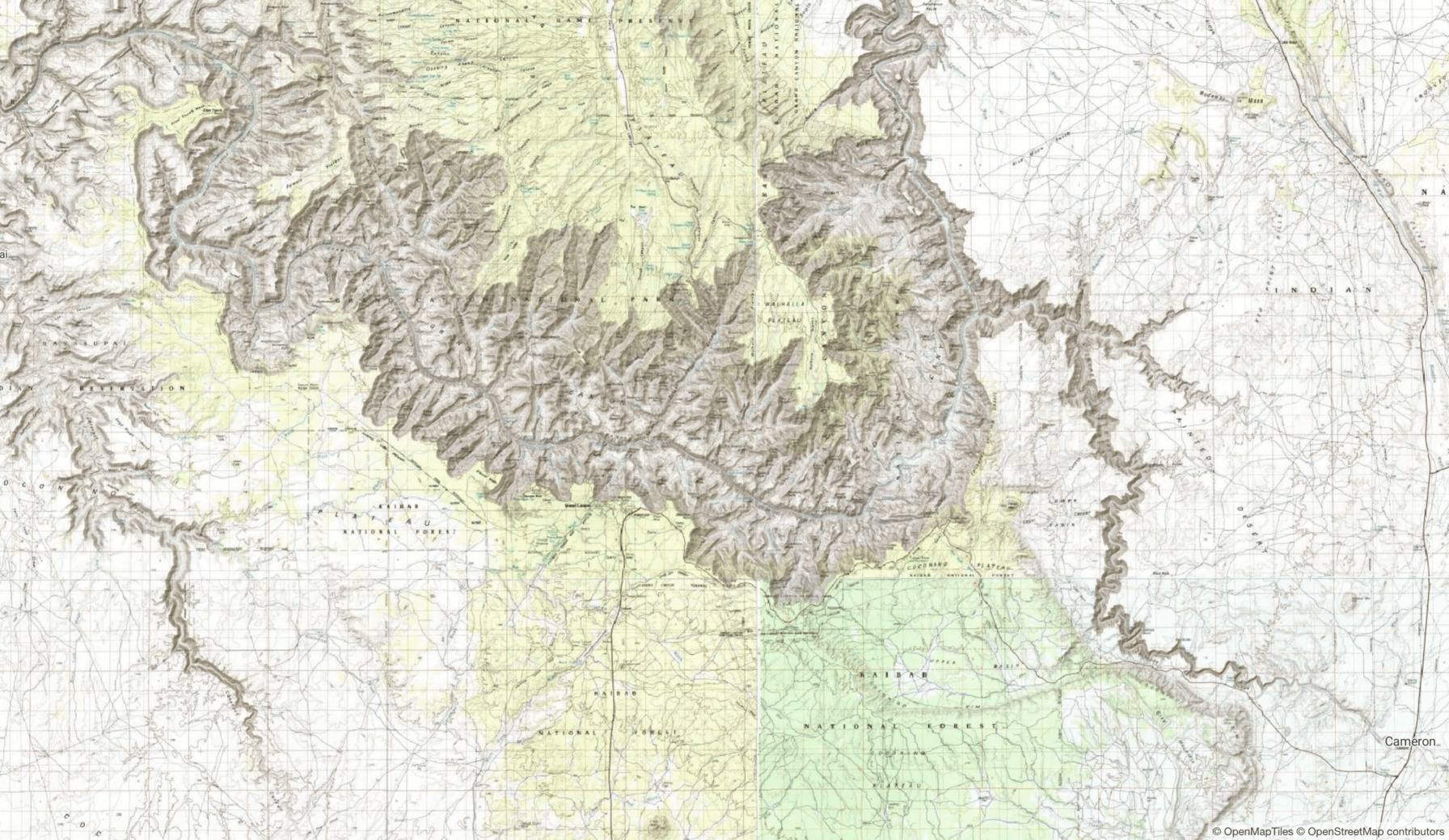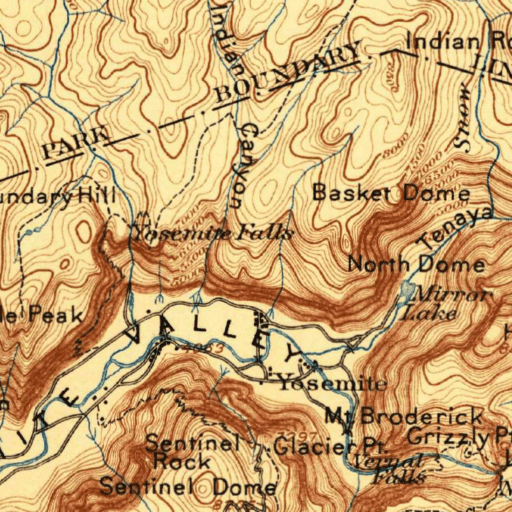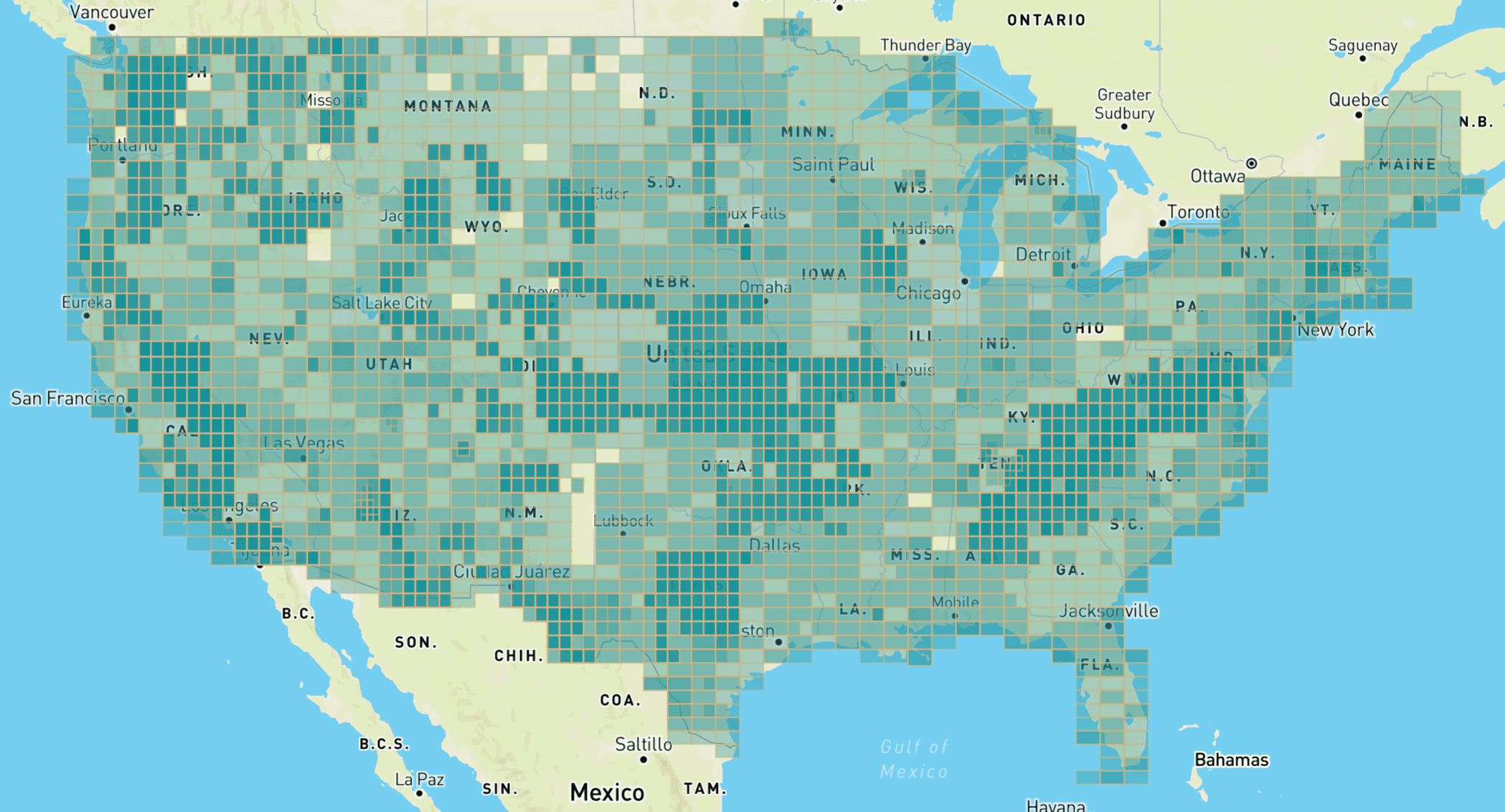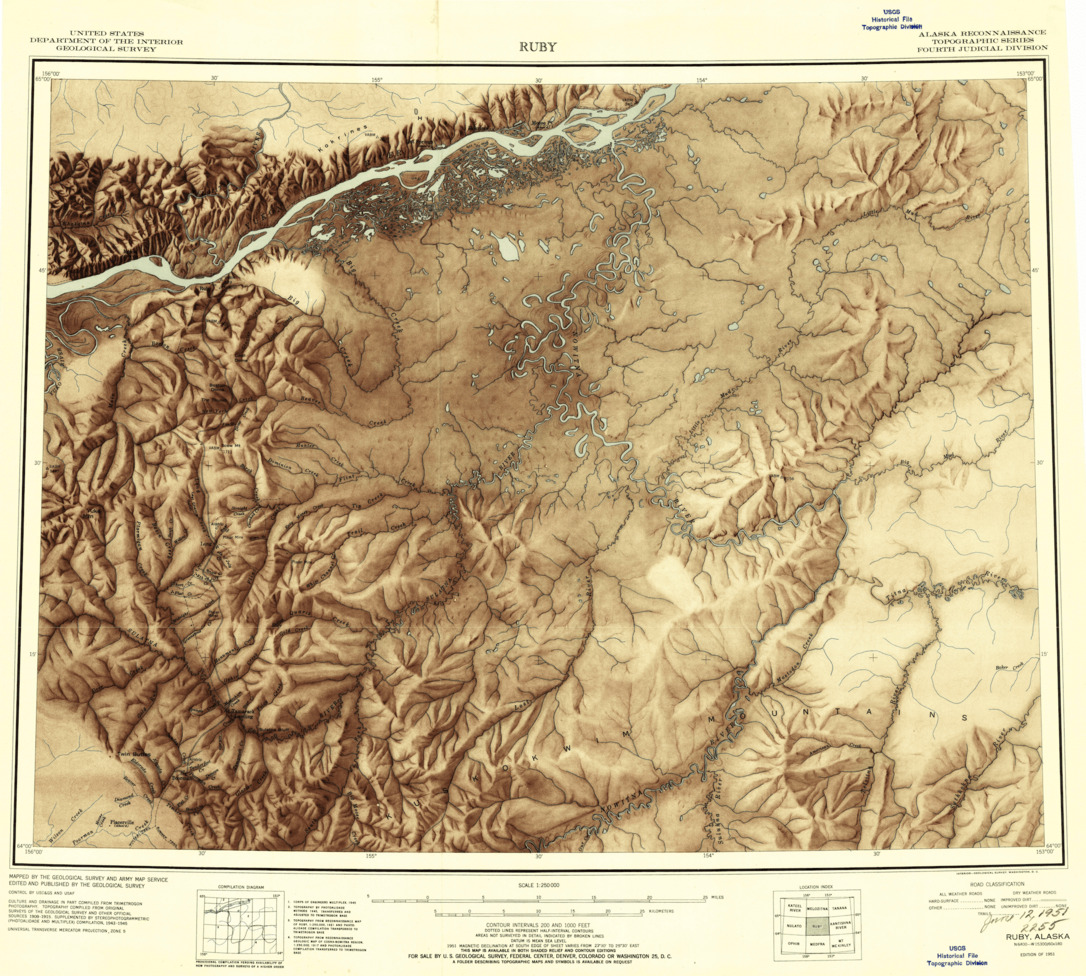rio-tiler plugin to read mercator tiles from USGS Topo Quads
Project description
usgs-topo-tiler
Python package to read Web Mercator map tiles from USGS Historical Topographic Maps, and utilities to create a MosaicJSON collection from these maps.
A mosaic of USGS historical maps around the Grand Canyon, with added relief shading.
Overview
I stumbled upon a hidden gem: the entire USGS historical topographic map archive, consisting of 183,112 digitized maps created between 1884 and 2006, is stored in Cloud-Optimized GeoTIFF (COG) format on AWS S3.
The fact that maps are accessible publicly and stored in COG format means that you can easily and cheaply set up a serverless function on AWS Lambda to serve map tiles on the fly.
The COG format is a backwards-compatible, cloud-native storage format for raster files that allow selected portions of the file to be read over the network without needing to download and parse the entire file. This fast random read access allows for dynamic tiling of map tiles on demand, without needing to preprocess and store any map data.
There are three parts to serving your own tiles:
usgs-topo-tiler: a library to extract a single Web Mercator tile from one source historical map.usgs-topo-tiler's CLI, which helps to construct MosaicJSON files. These files tellusgs-topo-mosaicwhat source files should be combined to create a single Web Mercator tile.usgs-topo-mosaic: a library to use a MosaicJSON file created above to create a seamless mosaic of tiles. This is designed to be deployed with AWS Lambda and AWS API Gateway as a serverless tile endpoint.
Generate a Web Mercator tile
Install
pip install usgs-topo-tiler 'rio-tiler>=2.0a6'
Usage
Here I'll show a quick overview of reading a single mercator tile from a single USGS historical map. If you're looking for a specific map, the simplest way is probably to use the National Map Viewer. Check the box for "Historical Topographic Maps", make sure the file format is "GeoTIFF". Click "Find Products", and then right click "Download" to get the HTTPS url to the GeoTIFF on S3.
For this demo, I'll make a mercator tile from an 1897 topographic map of Yosemite Valley.
Read a tile from a file over the internet
from usgs_topo_tiler import tile
url = 'https://prd-tnm.s3.amazonaws.com/StagedProducts/Maps/HistoricalTopo/GeoTIFF/CA/CA_Yosemite_299696_1897_125000_geo.tif'
# Mercator tile
x, y, z = 687, 1583, 12
tile, mask = tile(url, x, y, z, tilesize=512)
print(tile.shape)
# (3, 512, 512)
print(mask.shape)
# (512, 512)
Create image from tile
Note that if you're using rio-tiler v1, you should replace render with
array_to_image.
from rio_tiler.utils import render
buffer = render(tile, mask, img_format='png')
Write image to file
with open('yose_1897.png', 'wb') as f:
f.write(buffer)
You now have a 512x512 png image aligned with the Web Mercator grid, and because the source is a Cloud-optimized GeoTIFF, the image was made with a minimal number of requests to the source, and without reading the entire GeoTIF.
Create a MosaicJSON
The process described above is for create one tile. But often we want to join many mercator tiles to make a seamless web map. This is where MosaicJSON comes in. It describes how to join sources and where to place them.
This section outlines how to create a MosaicJSON from USGS historical topo
assets. This MosaicJSON can then be used with usgs-topo-mosaic to serve a web
map of tiles with AWS Lambda.
Install
When you install usgs-topo-tiler, it doesn't include dependencies necessary
for the CLI commands so as to keep the deployment size small when used with
usgs-topo-mosaic.
To install the additional CLI dependencies, run:
pip install 'usgs-topo-tiler[cli]'
Download bulk metadata
First you need to download metadata including at least the geospatial bounds of each map, and the URL of each map. It's possible to use the National Map API to retrieve such metadata, however I prefer to download a CSV of bulk metadata from S3. This file includes metadata on every image in their collection.
mkdir -p data
wget https://prd-tnm.s3-us-west-2.amazonaws.com/StagedProducts/Maps/Metadata/topomaps_all.zip -P data/
unzip topomaps_all.zip
data/topomaps_all.csv is the extracted bulk metadata file. data/readme.txt
has helpful information about what fields are in the bulk metadata file.
Download list of COG files:
Occasionally there are some files listed in the metadata that don't exist as
GeoTIFF. I download a list of the .tif files on S3 so that I can
cross-reference against the metadata and ensure that only files that exist are
included in the MosaicJSON.
This step is optional, but recommended.
mkdir -p data/
usgs-topo-tiler list-s3 \
--bucket 'prd-tnm' \
--prefix 'StagedProducts/Maps/HistoricalTopo/GeoTIFF/' \
--ext '.tif' \
> data/geotiff_files.txt
> wc -l data/geotiff_files.txt
183112 data/geotiff_files.txt
183112 COG files!
Create MosaicJSON
Now you're ready to start creating mosaics. This isn't entirely straightforward because maps were created at different times and at different scales in different regions of the U.S. So it's not usually as simple as creating a mosaic of all maps of a single scale, unless you're ok with having gaps in the mosaic spatially, where tiles might return empty data.
Footprints
One of the best way to visually see the results of a filtering query on the metadata is to generate footprints and then display them on a map.
Lets say we want to create a mosaic of mid-scale maps. We can use the
--filter-only cli flag to export newline-delimited GeoJSON of the query.
usgs-topo-tiler mosaic-bulk \
--meta-path data/topomaps_all.csv \
--s3-list-path data/geotiff_files.txt \
--min-scale 63360 \
--max-scale 249000 \
--filter-only \
> mid_scale_footprints.geojsonl
Then we can visualize this data, e.g. with my CLI for kepler.gl.
kepler mid_scale_footprints.geojsonl
This illustrates the core problem of these historical maps when making a MosaicJSON. Some areas have been mapped more than others, and some have never been mapped at this scale range. If you were to create a MosaicJSON from these parameters, you'd get empty images when requesting data over Northern Montana and Western Texas.
Generate MosaicJSON
Once you know the desired parameters of your query, remove the --filter-only
flag to generate the MosaicJSON. For example:
usgs-topo-tiler mosaic-bulk \
--meta-path data/topomaps_all.csv \
--s3-list-path data/geotiff_files.txt \
--min-scale 63360 \
--max-scale 249000 \
> mid_scale_mosaic.json
mid_scale_mosaic.json is now a MosaicJSON file that can be used with
usgs-topo-mosaic to render a web map. Note, however that this uses a custom
asset string format, as described in Removing Map
Collars, and won't necessarily work with all other
MosaicJSON tools.
Examples
Low zoom, newest available
usgs-topo-tiler mosaic-bulk \
--meta-path data/topomaps_all.csv \
--s3-list-path data/geotiff_files.txt \
--min-scale 250000 \
> mosaic_low.json
Medium zoom, newest available, filling in with lower-resolution maps where necessary
usgs-topo-tiler mosaic-bulk \
--meta-path data/topomaps_all.csv \
--s3-list-path data/geotiff_files.txt \
--min-scale 63360 \
> mosaic_medium.json
Medium zoom, oldest available, filling in with lower-resolution maps where necessary
usgs-topo-tiler mosaic-bulk \
--meta-path data/topomaps_all.csv \
--s3-list-path data/geotiff_files.txt \
--min-scale 63360 \
--sort-preference oldest \
> mosaic_medium_oldest.json
High zoom, newest available, continental U.S. only
usgs-topo-tiler mosaic-bulk \
--meta-path data/topomaps_all.csv \
--s3-list-path data/geotiff_files.txt \
--min-scale 24000 \
--max-scale 63359 \
`# Lower 48 states only` \
--bounds '-161.96,12.85,-55.01,50.53' \
> mosaic_high.json
API
Usage: usgs-topo-tiler mosaic-bulk [OPTIONS]
Create MosaicJSON from CSV of bulk metadata
Options:
--meta-path PATH Path to csv file of USGS bulk metadata dump
from S3 [required]
--s3-list-path PATH Path to txt file of list of s3 GeoTIFF files
--min-scale FLOAT Minimum map scale, inclusive
--max-scale FLOAT Maximum map scale, inclusive
--min-year FLOAT Minimum map year, inclusive
--max-year FLOAT Maximum map year, inclusive
--woodland-tint / --no-woodland-tint
Filter on woodland tint or no woodland tint.
By default no filtering is applied.
--allow-orthophoto Allow orthophoto [default: False]
--bounds TEXT Bounding box for mosaic. Must be of format
"minx,miny,maxx,maxy"
-z, --minzoom INTEGER Force mosaic minzoom
-Z, --maxzoom INTEGER Force mosaic maxzoom
--quadkey-zoom INTEGER Force mosaic quadkey zoom
--sort-preference [newest|oldest|closest-to-year]
Method for choosing assets within a given
mercator tile at the quadkey zoom.
[default: newest]
--closest-to-year INTEGER Year used for comparisons when preference is
closest-to-year.
--filter-only Output filtered GeoJSON features, without
creating the MosaicJSON. Useful for
inspecting the footprints [default: False]
--help Show this message and exit.
Addendum
Removing map collars
All of the USGS historical maps have collars, regions of space around the map where metadata is printed. In order to create continuous map tiles from a collection of these maps, these collars have to be clipped, so that only the map is showing.
These maps are georeferenced, which means that it's straightforward to remove the collar when you know the actual bounds contained in the map. However, I've found that there's no reliable way to determine the bounds on the fly with just the image and its filename.
While building the mosaic ahead of time, you have access to this information, but with the usual tiling setup, you'd only have access to the URL and image while tiling.
To get around this, I apply a "hack" to the MosaicJSON format. Instead of just encoding a URL string, I encode the url and the bounds of the map as a JSON string.
Summary: when you build a mosaic using the cli in this library, it encodes a
non-standard MosaicJSON that works well with the usgs-mosaic-tiler tiler, but
isn't necessarily readable by other MosaicJSON tools
Project details
Release history Release notifications | RSS feed
Download files
Download the file for your platform. If you're not sure which to choose, learn more about installing packages.















